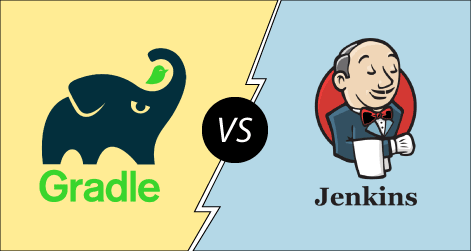Gradle vs. Jenkins
Jenkins is an open-source automation tool. It is written in Java and supports built-in plugins for the software development process. It is used to test the software projects and makes it easy for developers to create a new project or integrate changes to the existing projects. Jenkins integrates all kinds of software development life cycle processes such as build, document, stage, package, test, deploy, static analysis, and more. It supports continuous integration with the help of plugins; they allow the integration of various DevOps stages. To integrate a particular tool, we have to install the plugins for that tool. For example, Maven Project, Git, HTML Publisher, Amazon EC2, etc.
Jenkins is an extendable continuous integration server. In a nutshell, CRM service Jenkins CI (Continuous Integration) is the leading open-source continuous integration server. It facilitates with imprecise 300 plugins to support building and testing virtually any project.
Some significant benefits of Jenkins are as following:
- It does not require any additional installation.
- Jenkins is easy to configure and modify.
- It can be configured according to the requirements of CI (Continuous Integration) and CD (continuous Development).
- Jenkins is platform-independent so that it is available for different operating systems as well as platforms.
- It has a rich plugin system.
- It provides easy support.

Gradle is a powerful build tool for the JVM. It primarily focuses on build automation and supports multi-language development. If we are building, testing, publishing, and deploying software on any platform, Gradle provides a flexible model to support the entire development lifecycle from compiling and deploying the project.
Gradle uses Java and Groovy-based DSL (Domain Specific Language) instead of XML (Extensible Markup Language) for project declaration and configuration. It uses a DAG (Directed Acyclic Graph) to define the order of executing the task. Gradle offers an elastic model that can help the development lifecycle from compiling and packaging code for web and mobile applications. It provides support for the building, testing, and deploying software on different platforms. It has been developed for building automation on many languages and platforms, including Java, Scala, Android, C / C ++, and Groovy. It is the official build tool for Android. Gradle provides integration with several development tools and servers, including Eclipse, IntelliJ, Jenkins, and Android Studio.
Some significant benefits of Gradle are as following:
- Gradle allows us to write the build script with Java programing language.
- It is easy to use and maintain.
- It supports dependency management
- It facilitates with high performance and scalable builds.
- Gradle integration process is quite easier.
- It supports a multi-project structure.
- It is easy to migrate to Gradle from Maven or other build tools.
| Gradle | Jenkins |
|---|---|
| It is an open-source build tool written in Java, Kotlin, and Groovy. | It is an open-source build tool written in Java. |
| It is not an integration server. | It is a continuous integration server. |
| It facilitates with two types of plugins to support the build process of the project. | It facilitates with imprecise 300 plugins to support building and testing virtually any project. |
| It provides integration with several development tools and servers, including Eclipse, IntelliJ, Jenkins, and Android Studio. | It integrates all kinds of SDLC processes such as build, document, stage, package, test, deploy, static analysis, and more. |
| It is easy to migrate to Gradle from other build tools. | Jenkins does not provide the migration from other tools. |
| It supports multi-project builds. | It does not support multi-project build. |
